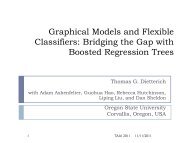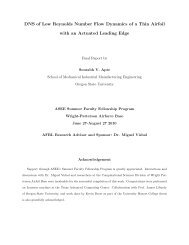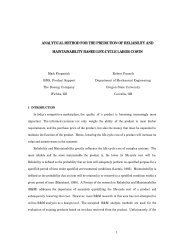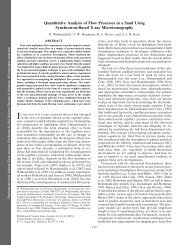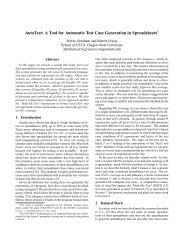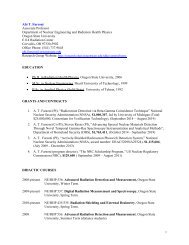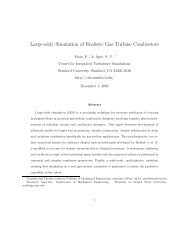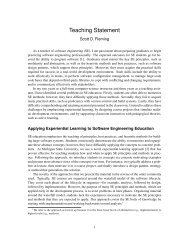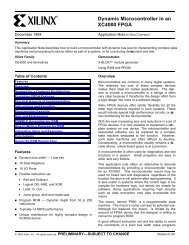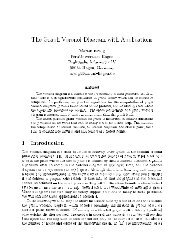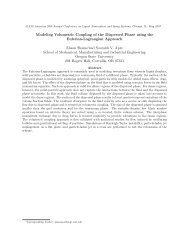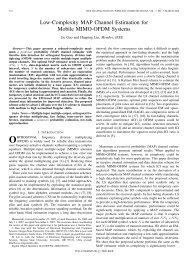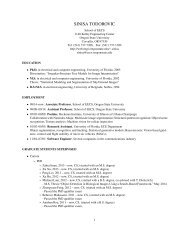Visualization of Diversity in Large Multivariate Data Sets
Visualization of Diversity in Large Multivariate Data Sets
Visualization of Diversity in Large Multivariate Data Sets
You also want an ePaper? Increase the reach of your titles
YUMPU automatically turns print PDFs into web optimized ePapers that Google loves.
1060 IEEE TRANSACTIONS ON VISUALIZATION AND COMPUTER GRAPHICS, VOL. 16, NO. 6, NOVEMBER/DECEMBER 2010overall diversity looks like under GH is much more ambiguous (evenly“spread out” glyphs with evenly distributed colors, shapes, etc.; seeFig. 3(c)). On the other hand, us<strong>in</strong>g DM, it was likely much easier forparticipants to understand exactly how very low and very high diversityappear visually (very low and very high total color density <strong>of</strong> theentire visual region, respectively; see Figs. 1 (a) and (c)), and we believethis led them to be more confident <strong>in</strong> choos<strong>in</strong>g responses at bothends <strong>of</strong> the diversity spectrum when us<strong>in</strong>g DM for Q2 questions.Analysis <strong>of</strong> Results for Q3. What is the most/least diverse attribute<strong>in</strong> the data set represented <strong>in</strong> this picture? The results for Q3 verymuch favored DM. There was conv<strong>in</strong>c<strong>in</strong>g evidence for an effect <strong>of</strong> visualizationmethod on error distance for both collections <strong>of</strong> data sets,A and B, F(1,38)=75.54, p = 1.45 × 10 −10 and F(1,38)=13.565,p = 0.0007, respectively. In addition, there was suggestive but <strong>in</strong>conclusiveevidence for an effect <strong>of</strong> visualization method on response time<strong>in</strong> phase 1, F(1,38)=3.50, p = 0.07. These results appear to confirmour <strong>in</strong>itial hypothesis that users would perform better—both <strong>in</strong> terms<strong>of</strong> error distance and response time—when mak<strong>in</strong>g judgments aboutthe diversity <strong>of</strong> a s<strong>in</strong>gle attribute when us<strong>in</strong>g DM than when us<strong>in</strong>g GH.Interest<strong>in</strong>gly, participants us<strong>in</strong>g GH appeared to perform worse onQ3 questions where the correct answer was an attribute assigned to aspatial axis, likely due to GH’s ambiguous many-to-one spatial mapp<strong>in</strong>g.In contrast, participants us<strong>in</strong>g DM did not appear to favor anys<strong>in</strong>gle attribute for questions <strong>of</strong> this type. Aga<strong>in</strong>, this suggests thatDM’s treatment <strong>of</strong> all attributes as equal is one <strong>of</strong> its strengths.Analysis <strong>of</strong> Results for Q4. Which value <strong>of</strong> attribute X conta<strong>in</strong>s themost/least objects? As with Q3, the results for Q4 very much favoredDM. For questions <strong>of</strong> this type, there was conv<strong>in</strong>c<strong>in</strong>g evidence for aneffect <strong>of</strong> visualization method on error distance for both collections <strong>of</strong>data sets A and B, F(1,38)=7.58, p = 0.009 and F(1,38)=25.18,p = 1.26 × 10 −5 , respectively, and there was suggestive but <strong>in</strong>conclusiveevidence for an effect <strong>of</strong> visualization method on response time <strong>in</strong>phase 1, F(1,38) =2.61, p = 0.11. Aga<strong>in</strong>, these results support our<strong>in</strong>itial hypothesis that users would be able to more quickly and moreaccurately make judgments about relative abundances with<strong>in</strong> a s<strong>in</strong>gleattribute when us<strong>in</strong>g DM than when us<strong>in</strong>g GH.Summary. The results across Q1–Q4 consistently supported ourhypothesis that users would be able to make more accurate judgmentsabout various aspects <strong>of</strong> the diversity <strong>of</strong> data when us<strong>in</strong>g DM thanwhen us<strong>in</strong>g GH. While we found some evidence suggest<strong>in</strong>g that usersperformed more quickly with DM than with GH, these results werenot conclusive. Similarly, we found no conclusive evidence that size<strong>of</strong> data set had an effect on user performance for questions <strong>of</strong> type Q1.6.3 Subjective EvaluationAfter each participant answered all <strong>of</strong> the questions <strong>of</strong> types Q1–Q4for a particular method, he or she also completed a short questionnaireon that method. The questionnaire, whose form we adopted from[33], consisted <strong>of</strong> n<strong>in</strong>e Likert-style statements, where participants wereasked to <strong>in</strong>dicate their level <strong>of</strong> agreement on a scale <strong>of</strong> 1 (strongly disagree)to 5 (strongly agree), and three open-ended questions.Table 4 lists each <strong>of</strong> the Likert-style questions along with the participants’mean responses for both GH and DM. Participants slightlyfavored DM over GH <strong>in</strong> mak<strong>in</strong>g judgments <strong>of</strong> diversity componentsand this is consistent with their performance <strong>in</strong> the objective portion<strong>of</strong> the study. Participants also slightly favored DM over GH <strong>in</strong> terms<strong>of</strong> applicability, ease <strong>of</strong> understand<strong>in</strong>g, and aff<strong>in</strong>ity.In addition to the Likert-style statements, the questionnaires <strong>in</strong>cludedthe follow<strong>in</strong>g three open-ended questions:O1) What aspect(s) <strong>of</strong> this method did you like most?O2) What aspect(s) <strong>of</strong> this method did you dislike most?O3) If possible, how would you change this method to improve it?Many participants <strong>in</strong>dicated an aff<strong>in</strong>ity for GH because it was <strong>in</strong>tuitive,<strong>in</strong> that, as the diversity <strong>of</strong> the underly<strong>in</strong>g data <strong>in</strong>creased, sotoo did the diversity <strong>of</strong> the visual properties (color, shape, size, etc.)<strong>of</strong> the generated visualization. On the other hand, many participantsexpressed concern about GH’s ambiguous spatial layout, which theyfound confus<strong>in</strong>g.Table 4. Mean responses to each <strong>of</strong> n<strong>in</strong>e Likert-style statementspresented to participants immediately after us<strong>in</strong>g each visualizationmethod. These responses are based on a scale <strong>of</strong> 1 (strongly disagree)to 5 (strongly agree). Standard deviations are shown <strong>in</strong> parentheses.Statement GH DML1) I was able to compare the diversity <strong>of</strong> two data 3.75 (0.81) 3.93 (0.92)sets us<strong>in</strong>g this method.L2) I was able to judge the diversity <strong>of</strong> a s<strong>in</strong>gle 3.63 (0.90) 4.25 (0.84)data set us<strong>in</strong>g this method.L3) I was able to determ<strong>in</strong>e the most/least diverse 3.58 (0.96) 4.15 (0.86)attributes <strong>in</strong> a data set us<strong>in</strong>g this method.L4) I was able to determ<strong>in</strong>e the ethnicity with the 4.05 (0.88) 4.28 (0.82)most/least objects us<strong>in</strong>g this method.L5) After the <strong>in</strong>itial tra<strong>in</strong><strong>in</strong>g session, I knew how 3.33 (0.83) 3.55 (0.99)to use this method well.L6) After answer<strong>in</strong>g all <strong>of</strong> the questions, I knew 3.74 (0.88) 3.88 (0.91)how to use this method well.L7) There are def<strong>in</strong>itely times that I would like to 3.20 (1.04) 3.75 (0.93)use this method.L8) I found this method to be confus<strong>in</strong>g. 3.38 (1.21) 2.77 (1.13)L9) I liked us<strong>in</strong>g this method. 2.95 (0.96) 3.50 (1.01)Participants <strong>in</strong>dicated that they liked the “clean layout” <strong>of</strong> DM; thesimplicity <strong>of</strong> compar<strong>in</strong>g color opacity under DM; and its ability toeasily handle different data set sizes. On the other hand, some participantsdisliked compar<strong>in</strong>g the diversity <strong>of</strong> an attribute with severalbuckets (e.g. ethnicity) to that <strong>of</strong> an attribute with only a few buckets(e.g. gender). Interest<strong>in</strong>gly, though this appears to be an issue with GHas well, participants did not seem to notice it when us<strong>in</strong>g GH.F<strong>in</strong>ally, most participants (29 out <strong>of</strong> 40) preferred DM to GH. Ingeneral, participants tended to feel GH would be best suited for judg<strong>in</strong>gthe overall diversity <strong>of</strong> a data set, especially to determ<strong>in</strong>e if the setis not diverse. Interest<strong>in</strong>gly, this is <strong>in</strong> direct contradiction to their performance<strong>in</strong> questions Q1 and Q2 which favored DM. In contrast, participantsgenerally believed DM would be useful for <strong>in</strong>vestigat<strong>in</strong>g thedata more deeply and exam<strong>in</strong><strong>in</strong>g the diversity <strong>of</strong> <strong>in</strong>dividual attributes.7 DISCUSSION AND FUTURE WORKWe have presented 1) an <strong>in</strong>frastructure for study<strong>in</strong>g the problem <strong>of</strong> diversityvisualization and 2) a novel representation for visualiz<strong>in</strong>g thediversity <strong>of</strong> a large set <strong>of</strong> multivariate objects. The <strong>in</strong>frastructure <strong>in</strong>cludesa precise def<strong>in</strong>ition <strong>of</strong> diversity that takes both richness andevenness <strong>in</strong>to account, a method for generat<strong>in</strong>g synthetic data <strong>of</strong> controllablelevels <strong>of</strong> diversity, and a formal study design for evaluat<strong>in</strong>gdiversity visualization representations. Based on this def<strong>in</strong>ition andstudy design, we developed and evaluated our approach to diversityvisualization, the <strong>Diversity</strong> Map, which is based loosely on ideas fromboth parallel coord<strong>in</strong>ates and small multiple histograms. We show thatthe <strong>Diversity</strong> Map allows users to consistently and as or more accuratelyjudge elements <strong>of</strong> diversity than the only other exist<strong>in</strong>g methoddesigned to visualize diversity. While we believe we have taken apositive step <strong>in</strong> understand<strong>in</strong>g diversity visualization, there are severalissues left to address.Study Design Issues. First, while our study design focuses on staticvisualizations only, both DM and GH are <strong>in</strong>teractive visualizations.We avoided <strong>in</strong>teractive features to limit the scope <strong>of</strong> our study to firstunderstand the merits and shortcom<strong>in</strong>gs <strong>of</strong> DM and GH as representations.Future work will address the <strong>in</strong>teractive capabilities <strong>of</strong> DM.Additionally, implement<strong>in</strong>g GH required us to choose a mapp<strong>in</strong>g<strong>of</strong> attributes to the various visual properties <strong>of</strong> the representation (thethree spatial axes, color, size, shape, etc.). While we based our mapp<strong>in</strong>gon the one used by Pearlman et al. [25], our choices here nonethelessrepresent a possible threat to construct validity.F<strong>in</strong>ally, our study does not <strong>in</strong>clude a specific question to determ<strong>in</strong>ethe richness <strong>of</strong> variety <strong>of</strong> an attribute. At first glance, it would appearthat richness <strong>of</strong> variety was obvious <strong>in</strong> both methods. However,while richness is clearly communicated <strong>in</strong> DM and <strong>in</strong> the non-spatialattributes <strong>of</strong> GH (e.g. color, shape, size), it is not clear how well richnessis communicated <strong>in</strong> the spatial axes <strong>of</strong> GH (e.g. the richness <strong>of</strong>



